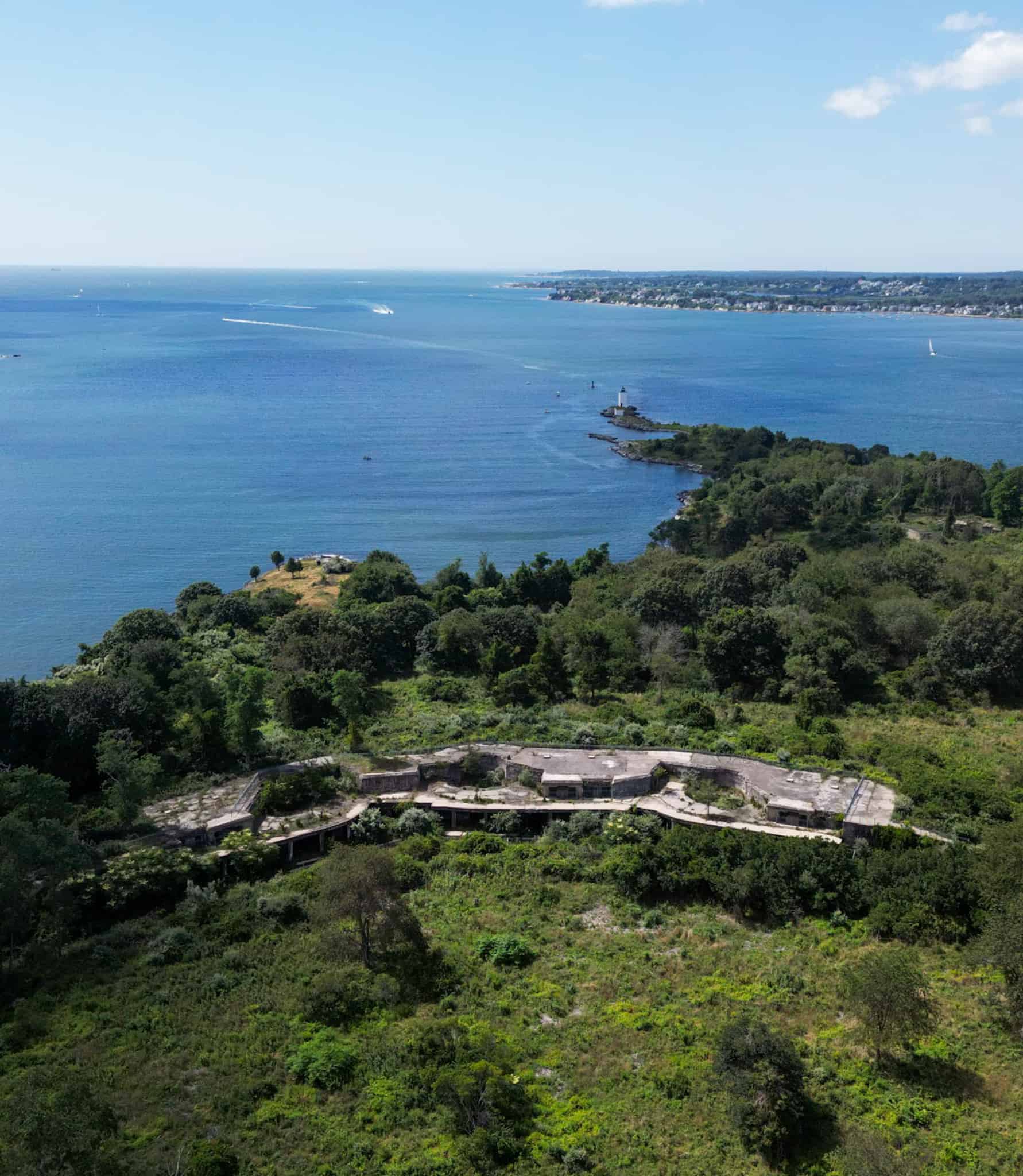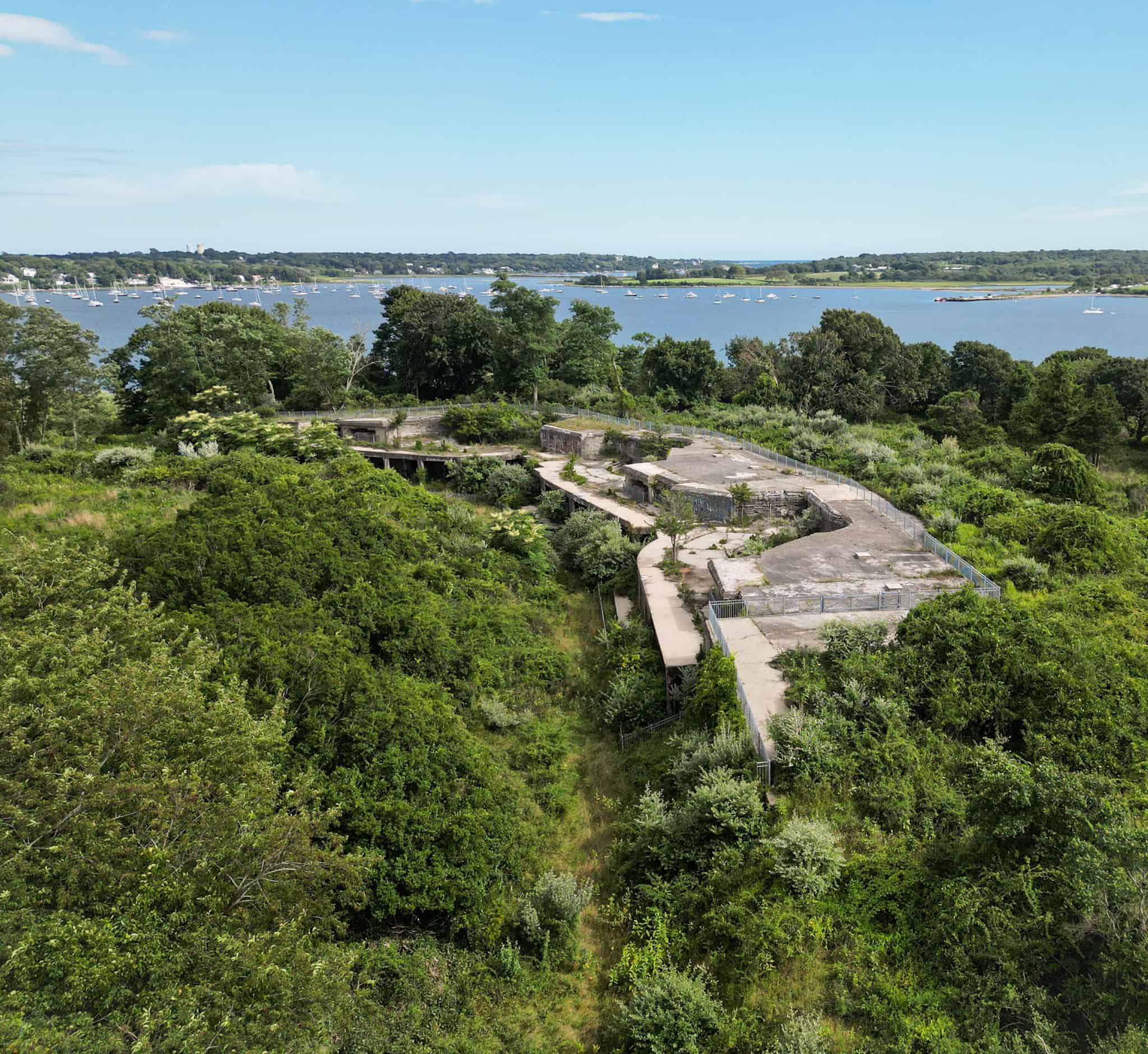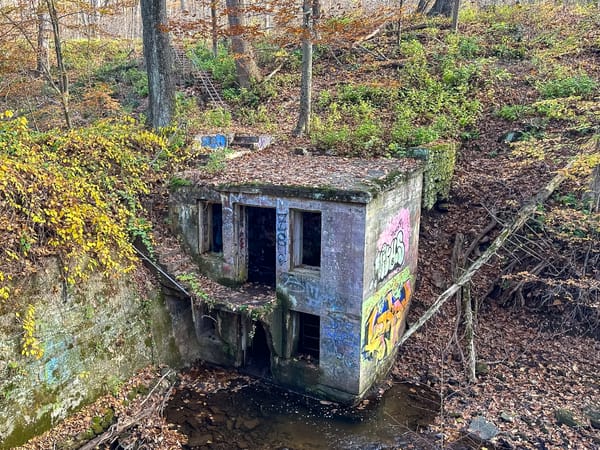Battery Hale (Dutch Island, RI)
Hidden deep within the overgrown landscape of Dutch Island off Jamestown, Rhode Island, Battery Hale stands as a haunting relic of the Endicott Era.

Hidden deep within the overgrown landscape of Dutch Island off Jamestown, Rhode Island, Battery Hale stands as a haunting relic of the Endicott Era, when America’s coastline bristled with concrete fortifications. Once part of Fort Greble and the Harbor Defenses of Narragansett Bay, this long-abandoned gun battery remains one of Rhode Island’s most remote and evocative military ruins.
Today, Battery Hale is a crumbling sentinel — reclaimed by vines, sea air, and time — yet still whispering stories of innovation, war, and the soldiers who once guarded these shores.

The Birth of Battery Hale and Fort Greble
In the late 19th century, technological advancements in artillery made traditional brick forts obsolete. In response, the U.S. government convened the Endicott Board in 1885 to design a new coastal defense system built around reinforced concrete batteries armed with long-range, high-caliber guns.
Fort Greble was established on Dutch Island as part of this sweeping modernization effort. Its mission was to defend the entrance to Narragansett Bay, Newport Harbor, and the Providence River — key maritime targets for any potential enemy fleet.
Construction on Battery Hale began in the mid-1890s and was completed by 1900. The battery was officially named in honor of Captain Nathan Hale, the famed Revolutionary War patriot remembered for his final words: “I only regret that I have but one life to lose for my country.”

Design and Armament
Battery Hale was a formidable structure, built of reinforced concrete and designed as a two-story coastal gun battery. The upper level housed three massive 10-inch M1888MII guns, each mounted on M1896 disappearing carriages.
These state-of-the-art guns, manufactured by Bethlehem Steel, could hurl 500-pound projectiles up to 15 miles — easily capable of striking any vessel entering the bay. When not in use, the guns “disappeared” behind protective parapets, lowered by counterweights to shield them from enemy fire.
The lower level held ammunition magazines and shell rooms, connected to the gun platforms above by electric Taylor-Raymond back-delivery shell hoists, installed in 1905 to replace the manual lifting systems of earlier designs.
Together, these features represented the height of coastal defense technology at the dawn of the 20th century.

Battery Hale in the World Wars
World War I
When the United States entered World War I, the military repurposed many of its coastal artillery guns for use in Europe. In 1918, one of Battery Hale’s 10-inch guns was dismounted and transferred to the Watervliet Arsenal in New York for potential overseas service.
Although Dutch Island saw no combat, the redistribution of its weaponry reflected a shift in warfare — from stationary defenses to mobile, global operations.
World War II
By 1942, the remaining guns at Battery Hale were declared obsolete. As part of the first major wartime scrap drive of World War II, all remaining weapons and carriages were dismantled and salvaged for steel. The once-mighty battery was left empty, its walls exposed to the sea breeze and the slow advance of nature.

Battery Hale Today
Today, Battery Hale sits quietly within the Dutch Island State Wildlife Management Area, its concrete surfaces cracked and overgrown with vines. The interior rooms that once stored powder and shells are now dark, silent chambers where moss and salt air reign.
Though the guns are long gone, the battery’s arched passageways, stairwells, and commanding ocean views make it one of Rhode Island’s most atmospheric abandoned military sites. For those who reach it, the sense of isolation is profound — a mix of history, ruin, and wild beauty.
However, this is not an easy site to access. Dutch Island is only reachable by boat, and the trails leading to Battery Hale are heavily overgrown. Visitors should be well-prepared and respectful of the terrain and local wildlife.
Visiting Battery Hale
Reaching Battery Hale is part of the adventure. Most visitors launch from Fort Getty State Park in Jamestown, which allows for kayak or small-boat access to Dutch Island. Once ashore, it’s a roughly quarter-mile bushwhack through thick brush to the ruins.
Visitor Information
- 📍 Address: Dutch Island, Jamestown, Rhode Island
- 🌐 GPS Coordinates: 41.502389, –71.400222
- 🚤 Access: By boat or kayak only (launch from Fort Getty State Park)
- 🪶 Trail Distance: Approx. ¼ mile through overgrown terrain
- 🅿️ Parking: Available at Fort Getty State Park (summer fee applies)
- ⚠️ Important: This is an abandoned structure; exercise caution, wear long pants, and bring bug spray.
Why Battery Hale Matters
Though isolated and crumbling, Battery Hale is one of Rhode Island’s most hauntingly beautiful historic sites. It embodies the evolution of American coastal defense — from the grand masonry forts of the 1800s to the industrial precision of the Endicott Era.
Standing on Dutch Island, surrounded by the sounds of the bay and the rustle of wind through overgrown corridors, visitors can almost hear the echoes of the soldiers who once stood watch here more than a century ago.
Battery Hale isn’t just a ruin — it’s a monument to human ingenuity, a symbol of shifting military strategy, and a poetic reminder of how even the strongest fortifications yield to time and nature.
Quick Facts
- 🏗 Constructed: Late 1890s – 1900
- ⚙️ Armament: Three 10-inch M1888MII guns on M1896 disappearing carriages
- 💰 Guns Manufactured By: Bethlehem Steel Company
- ⚡ Shell Hoists: Electric Taylor-Raymond (installed 1905)
- 🕰 Decommissioned: Guns removed in 1918 & 1942
- 🏞 Now Part Of: Dutch Island State Wildlife Management Area
- ⚠️ Access: By boat only; overgrown and unmaintained
Final Thoughts
Battery Hale is one of Rhode Island’s most remote and rewarding historical sites — a fortress reclaimed by nature and time. For those willing to make the journey, it offers an unforgettable glimpse into the past, where engineering ambition met the relentless rhythm of the sea.
From the crumbling concrete to the panoramic views of Narragansett Bay, Battery Hale remains a symbol of endurance — a silent chapter in the story of America’s coastal defenses.



